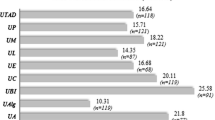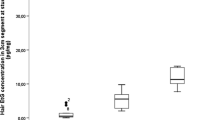Abstract
Background
Ethyl glucuronide (EtG) in hair has emerged as a useful biomarker for detecting alcohol abuse and monitoring abstinence. However, there is a need to establish a reliable cutoff value for the detection of chronic and excessive alcohol consumption.
Methods
One hundred and twenty-five subjects were classified as teetotalers, low-risk drinkers, at-risk drinkers, or heavy drinkers. The gold standard for subjects' classifications was based on a prospective daily alcohol self-monitoring log. Subjects were followed for a 3-month period. The EtG diagnostic performance was evaluated and compared with carbohydrate-deficient transferring (CDT) and the activities of aspartate aminotransferase, alanine aminotransferase, and γ-glutamyl-transferase (γGT).
Results
A cutoff of >9 pg/mg EtG in hair, suggesting an alcohol consumption of >20/30 g (at-risk drinkers), and a cutoff of >25 pg/mg, suggesting a consumption of >60 g (heavy drinkers), were determined by receiver operating characteristic analysis. The EtG diagnostic performance was significantly better (P < 0.05) than any of the traditional biomarkers alone. EtG, as a single biomarker, yielded a stronger or similar diagnostic performance in detecting at-risk or heavy drinkers, respectively, than the best combination of traditional biomarkers (CDT and γGT). The combination of EtG with traditional biomarkers did not improve the diagnostic performance of EtG alone. EtG demonstrated a strong potential to identify heavy alcohol consumption, whereas the traditional biomarkers failed to do so. EtG was not significantly influenced by gender, body mass index, or age.
Conclusion
Hair EtG definitively provides an accurate and reliable diagnostic test for detecting chronic and excessive alcohol consumption. The proposed cutoff values can serve as reference for future cutoff recommendations for clinical and forensic use.

Similar content being viewed by others
Abbreviations
- ASAT:
-
Aspartate aminotransferase
- ALAT:
-
Alanine aminotransferase
- γGT:
-
γ-Glutamyl-transferase
- CDT:
-
Carbohydrate-deficient transferring
- EtG:
-
Ethyl glucuronide
- DASM log:
-
Daily Alcohol Self-monitoring log
- GC-MS/MS:
-
Gas chromatography-tandem mass spectrometry
- LOQ:
-
Limit of quantification
- ROC:
-
Receiver operating characteristic
- AUROC:
-
Area under the ROC curve
- BMI:
-
Body mass index
- OR:
-
Odds ratio
- CI:
-
Confidence interval
References
Rehm J, Gmel G, Sempos CT, Trevisan M (2003) Alcohol-related morbidity and mortality. Alcohol Res Health 27(1):39–51
WHO (2011) Global status report on alcohol and health. World Health Organization, Geneva. Accessed 11 Feb 2011
Conigrave KM, Degenhardt LJ, Whitfield JB, Saunders JB, Helander A, Tabakoff B (2002) CDT, GGT, and AST as markers of alcohol use: the WHO/ISBRA collaborative project. Alcohol Clin Exp Res 26(3):332–339
Arndt T (2001) Carbohydrate-deficient transferrin as a marker of chronic alcohol abuse: a critical review of preanalysis, analysis, and interpretation. Clin Chem 47(1):13–27
Fleming MF, Anton RF, Spies CD (2004) A review of genetic, biological, pharmacological, and clinical factors that affect carbohydrate-deficient transferrin levels. Alcohol Clin Exp Res 28(9):1347–1355
Sillanaukee P (1996) Laboratory markers of alcohol abuse. Alcohol Alcohol 31(6):613–616
Sillanaukee P, Olsson U (2001) Improved diagnostic classification of alcohol abusers by combining carbohydrate-deficient transferrin and gamma-glutamyltransferase. Clin Chem 47(4):681–685
Anton RF, Lieber C, Tabakoff B (2002) Carbohydrate-deficient transferrin and gamma-glutamyltransferase for the detection and monitoring of alcohol use: results from a multisite study. Alcohol Clin Exp Res 26(8):1215–1222
Chen J, Conigrave KM, Macaskill P, Whitfield JB, Irwig L (2003) Combining carbohydrate-deficient transferrin and gamma-glutamyltransferase to increase diagnostic accuracy for problem drinking. Alcohol Alcohol 38(6):574–582
Rinck D, Frieling H, Freitag A, Hillemacher T, Bayerlein K, Kornhuber J, Bleich S (2007) Combinations of carbohydrate-deficient transferrin, mean corpuscular erythrocyte volume, gamma-glutamyltransferase, homocysteine and folate increase the significance of biological markers in alcohol dependent patients. Drug Alcohol Depend 89(1):60–65
Alt A, Janda I, Seidl S, Wurst FM (2000) Determination of ethyl glucuronide in hair samples. Alcohol Alcohol 35(3):313–314
Janda I, Weinmann W, Kuehnle T, Lahode M, Alt A (2002) Determination of ethyl glucuronide in human hair by SPE and LC-MS/MS. Forensic Sci Int 128(1–2):59–65
Yegles M, Labarthe A, Auwarter V, Hartwig S, Vater H, Wennig R, Pragst F (2004) Comparison of ethyl glucuronide and fatty acid ethyl ester concentrations in hair of alcoholics, social drinkers and teetotallers. Forensic Sci Int 145(2–3):167–173
Politi L, Morini L, Leone F, Polettini A (2006) Ethyl glucuronide in hair: is it a reliable marker of chronic high levels of alcohol consumption? Addiction 101(10):1408–1412
Jurado C, Soriano T, Gimenez MP, Menendez M (2004) Diagnosis of chronic alcohol consumption. Hair analysis for ethyl-glucuronide. Forensic Sci Int 145(2–3):161–166
Skopp G, Schmitt G, Potsch L, Dronner P, Aderjan R, Mattern R (2000) Ethyl glucuronide in human hair. Alcohol Alcohol 35(3):283–285
Appenzeller BM, Agirman R, Neuberg P, Yegles M, Wennig R (2007) Segmental determination of ethyl glucuronide in hair: a pilot study. Forensic Sci Int 173(2–3):87–92
Kharbouche H, Steiner N, Morelato M, Staub C, Boutrel B, Mangin P, Sporkert F, Augsburger M (2010) Influence of ethanol dose and pigmentation on the incorporation of ethyl glucuronide into rat hair. Alcohol 44(6):507–514
Pragst F, Yegles M (2008) Determination of fatty acid ethyl esters (FAEE) and ethyl glucuronide (EtG) in hair: a promising way for retrospective detection of alcohol abuse during pregnancy? Ther Drug Monit 30(2):255–263
Kintz P, Villain M, Vallet E, Etter M, Salquebre G, Cirimele V (2008) Ethyl glucuronide: unusual distribution between head hair and pubic hair. Forensic Sci Int 176(1):87–90
Bendroth P, Kronstrand R, Helander A, Greby J, Stephanson N, Krantz P (2008) Comparison of ethyl glucuronide in hair with phosphatidylethanol in whole blood as post-mortem markers of alcohol abuse. Forensic Sci Int 176(1):76–81
Kintz P (2010) Consensus of the Society of Hair Testing on hair testing for chronic excessive alcohol consumption 2009. Forensic Sci Int 196(1–3):2
Liniger B, Nguyen A, Friedrich-Koch A, Yegles M (2010) Abstinence monitoring of suspected drinking drivers: ethyl glucuronide in hair versus CDT. Traffic Inj Prev 11(2):123–126
Morini L, Politi L, Polettini A (2009) Ethyl glucuronide in hair. A sensitive and specific marker of chronic heavy drinking. Addiction 104(6):915–920
Kronstrand R, Brinkhagen L, Nystrom FH (2011) Ethyl glucuronide in human hair after daily consumption of 16 or 32 g of ethanol for 3 months. Forensic Sci Int. doi:10.1016/j.forsciint.2011.01.044
Gmel G, Daeppen JB (2007) Recall bias for seven-day recall measurement of alcohol consumption among emergency department patients: implications for case-crossover designs. J Stud Alcohol Drugs 68(2):303–310
Lemmens P, Knibbe RA, Tan F (1988) Weekly recall and dairy estimates of alcohol consumption in a general population survey. J Stud Alcohol 49(2):131–135
Townshend JM, Duka T (2002) Patterns of alcohol drinking in a population of young social drinkers: a comparison of questionnaire and diary measures. Alcohol Alcohol 37(2):187–192
Pragst F, Balikova MA (2006) State of the art in hair analysis for detection of drug and alcohol abuse. Clin Chim Acta 370(1–2):17–49
Kharbouche H, Sporkert F, Troxler S, Augsburger M, Mangin P, Staub C (2009) Development and validation of a gas chromatography-negative chemical ionization tandem mass spectrometry method for the determination of ethyl glucuronide in hair and its application to forensic toxicology. J Chromatogr B Analyt Technol Biomed Life Sci 877(23):2337–2343
Helander A, Tabakoff B (1997) Biochemical markers of alcohol use and abuse: experiences from the Pilot Study of the WHO/ISBRA Collaborative Project on state and trait markers of alcohol. International Society for Biomedical Research on Alcoholism. Alcohol Alcohol 32(2):133–144
Stibler H (1991) Carbohydrate-deficient transferrin in serum: a new marker of potentially harmful alcohol consumption reviewed. Clin Chem 37(12):2029–2037
Appenzeller BM, Schuman M, Yegles M, Wennig R (2007) Ethyl glucuronide concentration in hair is not influenced by pigmentation. Alcohol Alcohol 42(4):326–327
Martins L, Binz T, Yegles M (2011) Influence of ethanol containing cosmetics on ethyl glucuronide concentration in hair. Ann Toxicol Anal 23:S1–10
Sporkert F, Kharbouche H, Augsburger M, Mangin P (2011) Positive EtG findings in hair as a result of cosmetic treatment—a case report. Ann Toxicol Anal 23:S1-9–S1-10
Musshoff F, Albermann E, Madea B (2010) Ethyl glucuronide and ethyl sulfate in urine after consumption of various beverages and foods—misleading results? Int J Legal Med 124(6):623–630
Thierauf A, Wohlfarth A, Auwarter V, Perdekamp MG, Wurst FM, Weinmann W (2010) Urine tested positive for ethyl glucuronide and ethyl sulfate after the consumption of yeast and sugar. Forensic Sci Int 202(1–3):e45–e47
Thierauf A, Gnann H, Wohlfarth A, Auwarter V, Perdekamp MG, Buttler KJ, Wurst FM, Weinmann W (2010) Urine tested positive for ethyl glucuronide and ethyl sulphate after the consumption of “non-alcoholic” beer. Forensic Sci Int 202(1–3):82–85
Hoiseth G, Yttredal B, Karinen R, Gjerde H, Christophersen A (2010) Levels of ethyl glucuronide and ethyl sulfate in oral fluid, blood, and urine after use of mouthwash and ingestion of nonalcoholic wine. J Anal Toxicol 34(2):84–88
Rosano TG, Lin J (2008) Ethyl glucuronide excretion in humans following oral administration of and dermal exposure to ethanol. J Anal Toxicol 32(8):594–600
Reisfield GM, Goldberger BA, Crews BO, Pesce AJ, Wilson GR, Teitelbaum SA, Bertholf RL (2011) Ethyl glucuronide, ethyl sulfate, and ethanol in urine after sustained exposure to an ethanol-based hand sanitizer. J Anal Toxicol 35(2):85–91
Sachs H (1995) Theoretical limits of the evaluation of drug concentrations in hair due to irregular hair growth. Forensic Sci Int 70(1–3):53–61
Helander A, Bottcher M, Fehr C, Dahmen N, Beck O (2009) Detection times for urinary ethyl glucuronide and ethyl sulfate in heavy drinkers during alcohol detoxification. Alcohol Alcohol 44(1):55–61
Halter CC, Dresen S, Auwaerter V, Wurst FM, Weinmann W (2008) Kinetics in serum and urinary excretion of ethyl sulfate and ethyl glucuronide after medium dose ethanol intake. Int J Legal Med 122(2):123–128
Aradottir S, Asanovska G, Gjerss S, Hansson P, Alling C (2006) Phosphatidylethanol (PEth) concentrations in blood are correlated to reported alcohol intake in alcohol-dependent patients. Alcohol Alcohol 41(4):431–437
Gnann H, Weinmann W, Engelmann C, Wurst FM, Skopp G, Winkler M, Thierauf A, Auwarter V, Dresen S, Bouzas NF (2009) Selective detection of phosphatidylethanol homologues in blood as biomarkers for alcohol consumption by LC-ESI-MS/MS. J Mass Spectrom 44(9):1293–1299
Wurst FM, Thon N, Aradottir S, Hartmann S, Wiesbeck GA, Lesch O, Skala K, Wolfersdorf M, Weinmann W, Alling C (2010) Phosphatidylethanol: normalization during detoxification, gender aspects and correlation with other biomarkers and self-reports. Addict Biol 15(1):88–95
Acknowledgments
This study was generously supported by a grant from the Swiss Foundation for Alcohol Research. The authors would like to thank Sara Petter for her assistance as well as Annette Jordan and Magali Dovat-Sabatella for their support in sample analysis.
Author information
Authors and Affiliations
Corresponding author
Rights and permissions
About this article
Cite this article
Kharbouche, H., Faouzi, M., Sanchez, N. et al. Diagnostic performance of ethyl glucuronide in hair for the investigation of alcohol drinking behavior: a comparison with traditional biomarkers. Int J Legal Med 126, 243–250 (2012). https://doi.org/10.1007/s00414-011-0619-9
Received:
Accepted:
Published:
Issue Date:
DOI: https://doi.org/10.1007/s00414-011-0619-9




